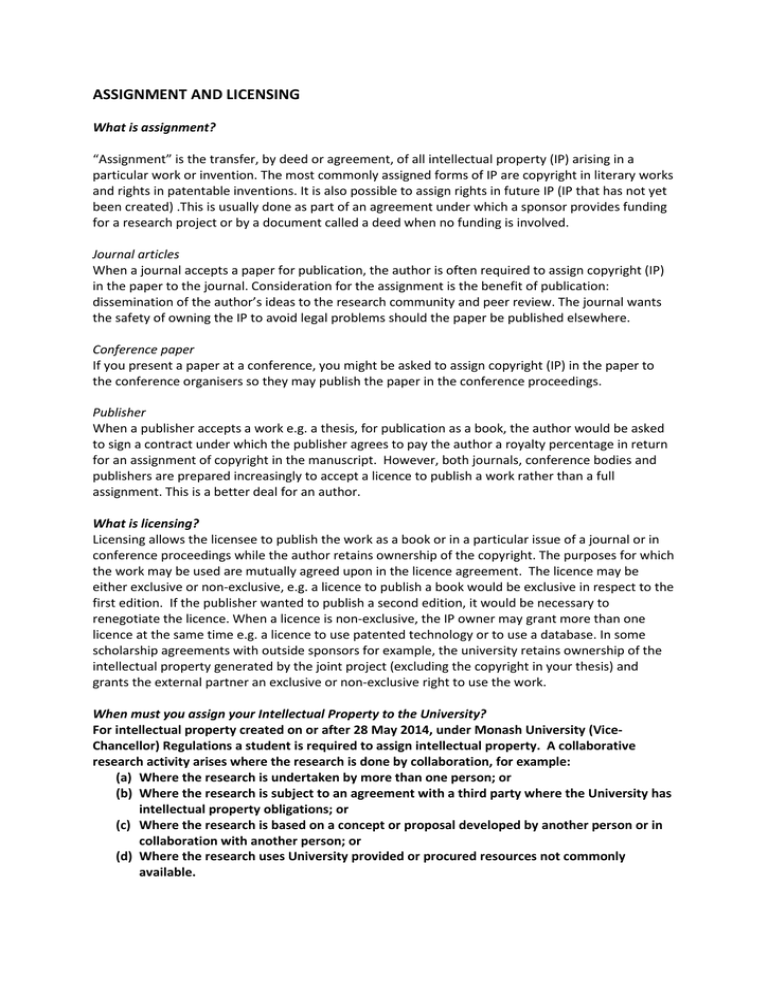ASSIGNMENT AND LICENSING
advertisement

ASSIGNMENT AND LICENSING What is assignment? “Assignment” is the transfer, by deed or agreement, of all intellectual property (IP) arising in a particular work or invention. The most commonly assigned forms of IP are copyright in literary works and rights in patentable inventions. It is also possible to assign rights in future IP (IP that has not yet been created) .This is usually done as part of an agreement under which a sponsor provides funding for a research project or by a document called a deed when no funding is involved. Journal articles When a journal accepts a paper for publication, the author is often required to assign copyright (IP) in the paper to the journal. Consideration for the assignment is the benefit of publication: dissemination of the author’s ideas to the research community and peer review. The journal wants the safety of owning the IP to avoid legal problems should the paper be published elsewhere. Conference paper If you present a paper at a conference, you might be asked to assign copyright (IP) in the paper to the conference organisers so they may publish the paper in the conference proceedings. Publisher When a publisher accepts a work e.g. a thesis, for publication as a book, the author would be asked to sign a contract under which the publisher agrees to pay the author a royalty percentage in return for an assignment of copyright in the manuscript. However, both journals, conference bodies and publishers are prepared increasingly to accept a licence to publish a work rather than a full assignment. This is a better deal for an author. What is licensing? Licensing allows the licensee to publish the work as a book or in a particular issue of a journal or in conference proceedings while the author retains ownership of the copyright. The purposes for which the work may be used are mutually agreed upon in the licence agreement. The licence may be either exclusive or non-exclusive, e.g. a licence to publish a book would be exclusive in respect to the first edition. If the publisher wanted to publish a second edition, it would be necessary to renegotiate the licence. When a licence is non-exclusive, the IP owner may grant more than one licence at the same time e.g. a licence to use patented technology or to use a database. In some scholarship agreements with outside sponsors for example, the university retains ownership of the intellectual property generated by the joint project (excluding the copyright in your thesis) and grants the external partner an exclusive or non-exclusive right to use the work. When must you assign your Intellectual Property to the University? For intellectual property created on or after 28 May 2014, under Monash University (ViceChancellor) Regulations a student is required to assign intellectual property. A collaborative research activity arises where the research is done by collaboration, for example: (a) Where the research is undertaken by more than one person; or (b) Where the research is subject to an agreement with a third party where the University has intellectual property obligations; or (c) Where the research is based on a concept or proposal developed by another person or in collaboration with another person; or (d) Where the research uses University provided or procured resources not commonly available. For intellectual property created prior to 28 May 2014, under the Monash University Statute 11.2 Intellectual Property and its regulations, there are three situations in which a student is required to assign intellectual property (other than copyright in the thesis): a) b) c) when the university has given you a specific contribution of funding/resources/facilities or apparatus AND you make or contribute to a patent worthy discovery or invention. The specific contribution made by the university must be something over and above a scholarship, supervision and the normal facilities required to undertake a research degree, for example, a piece of valuable equipment purchased solely for use by the student; where you are provided with background intellectual property owned by the university or your supervisor; when funding for your research is provided under an agreement between the university and a third party and the agreement states that the outcomes of the research are to be owned in whole or in part by a person other than yourself, the creator of the intellectual property. What are the benefits to me if I have to assign my intellectual property? The benefit of assigning your intellectual property(other than copyright in your thesis) to the university is that Monash can then protect your interests or involve you in research projects you may otherwise be unable to participate in. For example, collaborative research requires high levels of sharing and cooperation to succeed, which would be inhibited if individual intellectual property rights were maintained and enforced. For example, if your work leads to a patent worthy discovery, it is extremely unlikely that you could afford the costs of commercialising your own discovery or invention. But it is something the university could choose to do, if appropriate. Under its regulations you would become a co-owner of the patentable invention which you may include in your CV. You will also share in the commercial profits in accordance with the university’s patent revenue distribution statement. What is a deed of assignment? It is a short document under which you assign or transfer any rights you might acquire in any intellectual property which you may create during your candidature, other than copyright in your thesis. How do I assign? You will be asked to sign the appropriate Deed of Assignment at: http://www.monash.edu.au/migr/apply/accept/intellectual-property/ The original document should be retained in your academic unit and a copy attached to the intellectual property form you submit to the Monash Institute of Graduate Research upon enrolment.





